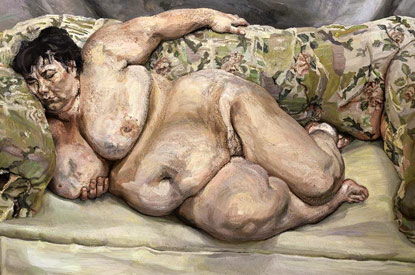The skin of the painter
She is beautiful, her body stretches, bends and arches with the tone and grace of an animal. And when she discards her shift, she moves with that lack of self consciousness and engagement that obviates desire. It is the artist who seems self conscious. He is shown holding a zebra by a leash, awkward, hardly daring to look at the dancer.
Yet this is Lucian Freud, an artist who reputedly establishes such intense intimacy with his models that he can strip away the vanities of their skin to the bare anatomical essentials. But there is little hint of intimacy in his paintings, no semblance of engagement. Nobody smiles. Many of his sitters are painted sleeping, as if he cannot bear to have a real human connection with them. And those that are not sleeping, look out at us in a way that that seem cold and disinterested. His skin tones are grey and a soiled beige, more livid around the genitals and nipples, the hair dull and untidy. His subjects seem lifeless. In the video, he tells of how he kept vigil by his dead sister for days as the body began to decompose.
An exceptionally shy and private man, who rarely gives interviews, it is like Freud can only engage intimately with people if he can turn them into anatomical specimens. He exposes their barest human essentials, strips away any personality, and declares, not without aggression, ‘there is no pretence here; this is the way you are.’
His skill as a painter is in no doubt. His botanical paintings and the paintings of his dog, have the same anatomical frankness as his human subjects. But perhaps this meticulous attention to detail also distances him from his sitters
The video shows clips of him strolling along the Regent’s Canal with a kestrel on his wrist. The beak and dark eye of the bird mirror his own hooked nose and penetrating stare. Does he have the same killers regard for his ‘prey’?
We wonder. Like a dream, the work of the conceptual artist tells us so much about their personality, though of course we perceive this through the filter of our own experience. So perhaps it is better to say that the work of an artist informs how they affect us, like an intimate conversation or like a session of psychotherapy. The art is the material of the counter-transference. We need to acknowledge this to get under the skin tones and creases of the artist. Freud knows this. His numerous naked self portraits reveal and conceal everything. He is, although he may wish to distance himself from the connection, the grandson of Sigmund Freud, the psychoanalyst who got under the psychological skin of his subjects but remained unseen behind the head of the couch in his green chair.
An exhibition of Lucian Freud, L’atelier (the studio), is currently showing at The Pompidou Centre in Paris.



